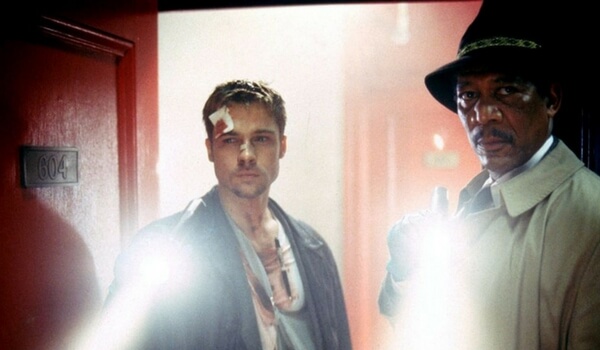
In partnership with Creative Screenwriting and ScreenCraft, “First Draft” is a series on everything to do with screenwriting.
Every story begins at your Initial Stimulus–that spark of an idea that captured your imagination. The thing that got you excited and revved up. That initial flash of creativity you just knew would make for a great movie idea.
Initial Stimulus is also something much deeper though. Simply put, it’s your inspired connection to that basic story idea.
Having an inspired connection to your story idea is significant because inspiration is significant. It’s important to recognize that inspiration comes from passion, whereas motivation does not. When you’re motivated to do something you want to accomplish that objective and then move on.
Inspiration is much more profound than motivation because it stems from passion. As such, it causes you to personally invest in what you’re working on. To connect to it emotionally. In short, motivation can be fleeting, while passion always endures.

Types of Initial Stimulus
The Initial Stimulus can come to us in many different forms. It can be an intriguing character, like the dark side of Tyler Durden in Fight Club. It can be fascinating subject matter or an event that interests you, such as the civil rights movement led by Dr. Martin Luther King, Jr. in the film, Selma, or one woman’s inspiring activism portrayed in Erin Brockovich.
Or the Initial Stimulus can just be a simple “what if” that comes from the ether of your own imagination. What if a serial killer used the seven deadly sins as his modus operandi? The “what if” behind the film Seven with Brad Pitt and Morgan Freeman.
 No matter how it comes to you though, it’s important to understand the psychological impact that the Initial Stimulus has on the overall creative process. Having an inspired connection to your story idea is crucial to story development.
No matter how it comes to you though, it’s important to understand the psychological impact that the Initial Stimulus has on the overall creative process. Having an inspired connection to your story idea is crucial to story development.
Why? Because it’s the driving force behind why you want to tell a particular story. It’s the momentum that will sustain you throughout the lengthy process of developing and writing a feature length screenplay. And it’s also the thing that can cause your story to crash and burn, killing your character in the process.

The Pitfall of Initial Stimulus
Having taught Screenwriting at the MFA level for almost two decades, as well as having professionally consulted on north of five-hundred screenplays and films, I can say that a mistake I see all too often is that the writer gets so excited about their Initial Stimulus, that they instantly jump in and start plotting.
Never stopping to first define the single most important building block of story–character. Character is the narrative cornerstone in building a screenplay with emotional resonance that an audience can connect with.
Jumping right in and plotting your story is the equivalent of eagerly hopping into your car to go somewhere cool and exciting… Only to have no idea where you’re going or how to get there.
It doesn’t make any sense. So why do screenwriters do this then? Two reasons.
One, because plotting a movie is one of the more creatively exciting parts of the entire story development process. It’s one of the things that gets the artistic adrenaline pumping. It’s enjoyable to do.
Secondly, as people we tend to be vertical thinkers, so sequencing and creating order (or plotting) is something that is intuitive, it comes natural to us. Think about it: if a person looks up at the stars at night, the first thing their mind will do is to form shapes and patterns out of the stars.
As humans, we’re hardwired to intuitively try to make order out of chaos. It’s called Pareidolia, which is where the mind perceives a familiar pattern of something where none actually exists.
The Negative Effect of Plotting First
This natural instinct of wanting to jump in and instantly create order by plotting our screenplay can end up causing all sorts of narrative repercussions.
Most notably of course, we end up with un-compelling characters that are afterthoughts–ones that lack authenticity. Instead, they become broad characterizations that are devices solely needed to serve our plot. Human chess pieces being moved around in a story in order to oblige a plot’s end result. Which is hands down the quickest way to cut the life of your screenplay short.
Not to mention, by putting the cart (plot) before the horse (character), we often end up losing track of that inspired connection (Initial Stimulus) we had with the basic story idea to begin with!
All of this is why there are more unfinished screenplays than finished ones. More first drafts that never see the light of day than do. And more just plain bad spec scripts out there than good ones.
So as you begin to develop your story idea, always remember that once you have your Initial Stimulus in place… Stop!
Resist that urge to jump in and start plotting the story. Fight that feeling of wanting to instantly work on plot. Instead, first develop and define the key building block of all successful stories–character.
In doing so, you’ll be able to better craft a plot that has emotional resonance that an audience can connect with. MM
This post originally appeared on the blog ScreenCraft. ScreenCraft is dedicated to helping screenwriters and filmmakers succeed through educational events, screenwriting competitions and the annual ScreenCraft Screenwriting Fellowship program, connecting screenwriters with agents, managers and Hollywood producers. Follow ScreenCraft on Twitter, Facebook, and YouTube.
Share:

